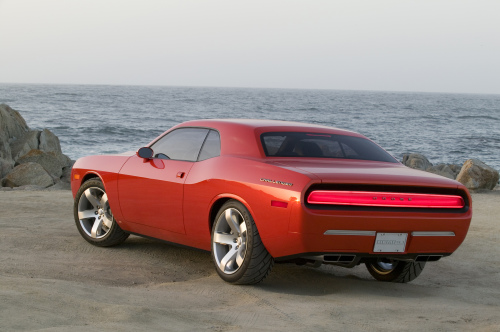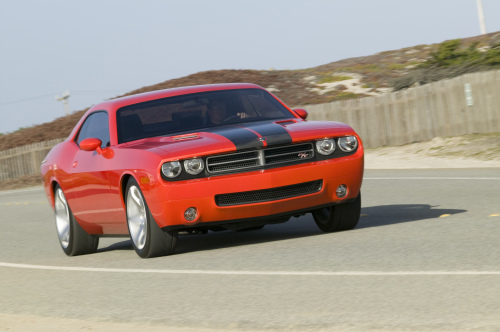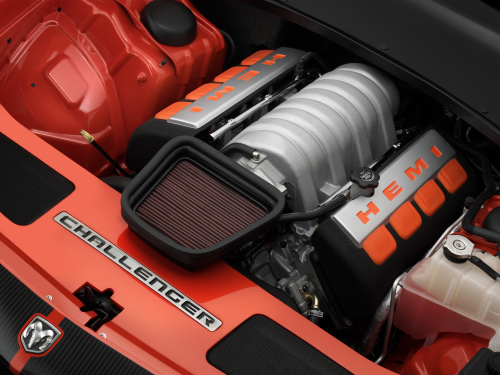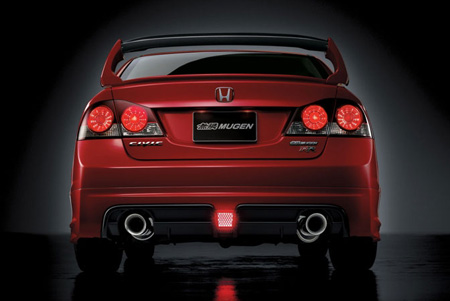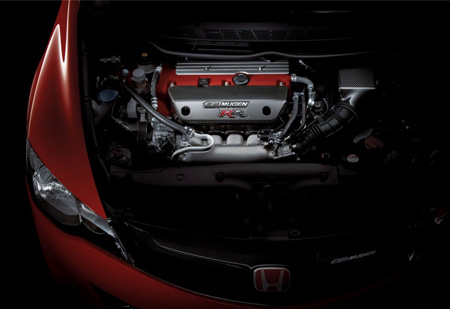Forum: Pics - Events, Parties, Other
The Rolls-Royce Phantom is a luxury saloon automobile made by Rolls-Royce Motor Cars, a BMW subsidiary. It was launched in 2003 and is the first Rolls-Royce model made under the ownership of BMW. It has a 6.8 L, 48-valve, V12 engine that produces 453 hp (338 kW) and 531 ftˇlbf (720 Nˇm) of torque. The engine is derived from BMW's existing V12 powerplant. It is 1.63 m (63 in) tall, 1.99 m (74.8 in) wide, 5.83 m (228 in) long, and weighs 2485 kg (5478 lb). The body of the car is built on an aluminium spaceframe and the Phantom can accelerate to 60 mph (100 km/h) in 5.7 s.
2006 Ford-Mustang-Giugiaro-Concept & the 2008 Ford Mustang Shelby GT500KR

First Look: 2009 Cadillac CTS-V
By Angus MacKenzie
Photography by Wesley Allison, the manufacturer
This is it. The fastest, most powerful Cadillac
ever built. The fastest, most powerful American sedan in history, for
that matter. Locked, loaded, and gunning for Europe's heavy-hitting
sport sedans-BMW M5, Mercedes-Benz E63 AMG, Audi
RS6. Read all that again. Now pinch yourself. No, you're not dreaming.
Motown -- well, GM at least -- has its mojo back. Meet Cadillac's
monster new CTS-V. Cadzilla, if you will.
Here
are the raw numbers: 550 horsepower at 6200 rpm. 550 pound-feet of
torque at 4000 rpm. They're only official "estimates," but as the
engine under the new CTS-V's
power-domed hood is fundamentally the same as the supercharged V-8
that's credited with 620-plus horsepower and at least 600 pound-feet in
the hot new Corvette
ZR1, you can safely assume the real SAE-certified figures will be
close. "I'm confident we'll disappoint nobody with the numbers," says
Ed Piatek, the CTS-V's program engineering manager.
There
are no performance figures yet, but by way of context, AMG's E63 Benz
nails 60 mph in 4.3 seconds. The new CTS-V weighs about the same and
has at least 43 more horses and 85 pound-feet more torque. Draw your
own conclusions: The car also has been extensively tested on the
legendary Nurburgring Nordschliefe, and while insiders are tight-lipped
on the actual lap time -- for now -- they will admit Cadzilla has
terrorized factory hotshoes from Munich out on the daunting 13-mile
road course. "People who've never been passed by a Cadillac have now
had that experience," smiles Piatek.
Piatek works for
the GM in-house hot-shop, High Performance Vehicle Operations, headed
by John Heinricy, and was the man tasked with overseeing the
transformation of the COTY-winning CTS into Cadzilla. He had good raw
material to work with: Unlike the previous model, the new CTS was
engineered from the outset with the high-performance V-series model in
mind, with extra stiffening and strengthening built in. "That was a
lesson we learned with the first CTS-V," says Piatek. "If you start
with this [idea] going in, there may be a small mass penalty on the
base car, but there's less cost and tooling needed to do the V."
As
a result, the basic CTS body structure is little altered. Most of the
changes that have been made-mainly around the front and rear suspension
cradles and the suspension links-are purely to handle the much higher
cornering loads induced by the specially developed 19-inch Michelin Pilot
Sport 2 tires and the prodigious torque output from the engine. On that
last point, everything rear of the front transmission flange has been
beefed up. There's a larger-diameter prop shaft, and asymmetric
halfshafts (one side is a 55mm-diameter unit, the other 35mm) to help
reduce wheelhop under full power launches).
- 10/or12mm wrench (can't ever remember)
- Tubing big enough to fit around bleeder valve
- Bottle for Brake Fluid
- A friend
Brake bleeding is essential whenever replacing a component of the brake system and it can also remove lag in the brake pedal.
Step 1: Place car on jack and remove tire on whichever brake you are going to perform the brake bleed on.
Step 2: Locate the brake bleed valve and remove rubbet grommet.
 3A7-4405-AB2D-2761DC15A96D/articles/maintenance/brake_bleed/caliper.jpg" border="0" />
3A7-4405-AB2D-2761DC15A96D/articles/maintenance/brake_bleed/caliper.jpg" border="0" />Step 3: Fix hose over brake bleed valve and put opposite end of hose into a container/bottle. ( Make sure bottle has enough brake fluid in it to submerge the end of hose.)
 3A7-4405-AB2D-2761DC15A96D/articles/maintenance/brake_bleed/bleed.jpg" border="0" />
3A7-4405-AB2D-2761DC15A96D/articles/maintenance/brake_bleed/bleed.jpg" border="0" />Step 4: Have a friend press down on the brake pedal several times until completely firm with the valve still closed.
Step 5: Open the valve on full turn with a wrench and let brake pedal reach the floor.
Step 6: Close the valve while your friend still has the pedal pushed to the floor.
Step 7: Again let your friend pump the brake pedal with the valve closed until it is completely firm.
Step 8: Repeat steps 5 and 6 several times until you notice it only takes one or two pumps to achieve full firmness of the brake pedal.
Step 9: Close valve firmly and place grommet over valve. Your finished!
NOTE: If you plan to bleed all calipers you need to follow proper brake bleeding sequence: Check your manual for propper brake bleeding sequence. I believe 98-01 is front left, front right, rear right and rear left. 94-97 is rear right, front left, rear left, front right.
The car I worked on was a 2002 Type-S and will apply up to the latest model year of the body type
Here is the standard wire diagram
| Description | Color | Location | Polarity | Notes |
| Constant | White | Ignition Harness | + | Shows power regardless of key position |
| Starter | Black/White | Ignition Harness | + | Shows power while key is at "START" |
| Ignition | Black/Yellow | Ignition Harness | + | Shows power while key is "ON" and "START" |
| Accesory | Black/Red | Ignition Harness | + | Shows power while key is "ON" only (this powers the Air/Heat) |
| Power Lock | White/Blue | Driver Kick | - | See picture below |
| Power Unlock | White/Green | Driver Kick | - | See picture below |
| Door Trigger | Lt Green/Red and Green | Security Plug | - | See picture below |
| Trunk/Hatch Trigger | Red | Security Plug | - | See picture below |
| Light Flash | Blue | Security Plug | - | See picture below |
And here is the picture to help with location:
 3A7-4405-AB2D-2761DC15A96D/articles/morningz/alarm_install/rsx_alarm_wires.jpg" height="411" width="600" />
3A7-4405-AB2D-2761DC15A96D/articles/morningz/alarm_install/rsx_alarm_wires.jpg" height="411" width="600" />Notes:
- The driver and passenger doors have seperate trigger wires, you MUST use diodes to properly isolate these to the alarm. Diodes are cheap (like $1.50 for a 3 pack at Radio Shack).
- Most alarms have a jumper or setting or input to change Parking Light polarity from (+) to (-), but this is set to positive output by default!
- Good luck mounting the siren! I swore and cursed and cut up my hands pretty good mounting and running the wire for the siren. The RSX engine bay is one of the most cramped and unforgiving engine bays I have ever dealt with, and i have done hundreds of alarm installs. While I did not do it in this install, I'd suggest pulling off the front nose for mounting and running of the wire
- Definitely pull off the "clamshell" housing around the steering column (it's 3 quick phillips screws) for better access to the ignition wiring and just more room to worj with in general under the dash there
The amount of continuous power that an amplifier produces is called RMS power. The higher the RMS figure, the louder and cleaner your music sounds.
Peak Power Output
Tells you the maximum wattage an amplifier can deliver as a brief burst during a musical peak. The RMS figure is more significant.
Frequency Response
The range of frequencies, low to high, the amp can reproduce. The standard is the range of human hearing, which is 20-20,000 Hz.
Signal to Noise Ratio
Measured in decibels (dB), this spec compares the strength of the desired signal (music) to the level of background noise. A higher value indicates less background noise.
THD at Rated RMS Power
The amount of change in harmonic content of the signal as it is amplified. A lower figure indicates less change and a more accurate amp. THD below 0.10% is inaudible.
Input Voltage
The input voltage used to measure the power output. Can range from 12 volts to 14.4 volts.
Power at 2 Ohms
This spec tells you how much more power your amp delivers when presented with a 2-ohm load. You can achieve a 2-ohm load by using two 4-ohm subs wired in parallel, or by using a 2-ohm sub.
Bridged Power
The output wattage (RMS) per bridged channel.
Minimum Impedance Bridged
The lowest impedance the amp is designed to handle when it is in bridged mode.
Preamp Outputs
Number of RCA outputs. An RCA output lets you pass the preamp signal from your head unit to external equalizers, amplifiers, and other equipment.
Speaker Level Inputs
Useful if you're adding an amp to a factory radio, or don't have enough preamp outputs on your aftermarket receiver.
Amplifier Class
The type of amplifier class the amp belongs to. The most common types are Class A, Class B, Class AB, and Class D.
Passive Equalizer
Allows you to fine tune your music at the preamp level with multi-band adjustability for maximum quality and control. Accepts RCA inputs from your aftermarket stereo and delivers RCA outputs for your amplifiers.
Electronic Crossover
Gives the user variable adjustment with different crossover points, allowing the user to remove unwanted frequencies from different preamp lines.
Example: channels A and B high-pass (80-460 Hz), channel C low-pass (50-210 Hz)
In-line crossovers
Crossovers put in-line with the patch cords (RCA) feeding your amplifier. They filter out unwanted frequencies. Low-pass models let frequencies below the cut-off point through and filter out the highs. High-pass models let frequencies above the cut-off point through and filter out the lows.
Tri-Way Crossover
A tri-Way crossover allows you to power a pair of stereo speakers and a subwoofer simultaneously from a Tri-Way compatible 2-channel amp. It's a cost-effective way to drive a subwoofer.
On any vehicle with a new ( or recently repaired ) manual transmission, the fresh contact surfaces of gears and synchronizers need to accumulate some careful break-in mileage in order to gradually mate up and work at maximum efficiency. The more frequently a gear is selected, the sooner its feel will improve.
If gear shifts are hurried or forced on a new synchronizers, they may not have time to equalize gear speeds for smooth engagement, resulting in a notchy, or rough feeling. Permanent damage to synchronizers and gear teeth can result and grinding will occur on engagement thereafter. Owners should be advised to be patient when shifting gears during break-in, avoid speed shifting and make sure to always depress and hold the cl**tch pedal to the floor until gear changes are completed.
Reminder: In cooler temperatures, shift effort may remain high until the transmission oil begins to warm up. As the transmission does not warm up as quickly as the engine, this normal characteristic may not change during short trips, especially in sub-freezing temperatures. If the transmission shifts properly after it has warmed up, a repair is not necessary.
Thanks to sabotage, Jason84, drmh, GR8One1020, Tegman98, and bostongraf for their inputs! If you find that something is amiss, use your best judgement to determine if it is a make or break issue. As always, drive safe and be aware of your surroundings.
Preliminary Checklist ( before you leave ):
__ 1. Check and adjust tire pressure, alignment. Ensure lug nuts are tightened properly, and tires are not excessively worn. No vibrations and not pulling to one side. If possible, jack up the car, remove the tires, and inspect for any punctures or bubbles. Ensure that your brake pads are not excessively worn. While the car is up in the air, check if the wheels spin freely. If not, you may have seized calipers or your brakes may need adjustment.
__ 2. Check and top off brake, cl**tch, motor oil, transmission, wiper, power steering fluid, coolant, and gas. Good idea to bring an extra quart of oil. Make sure drain bolts, fill bolts, and filters are tightened properly.
__ 3. Inspect engine. Include battery and charging system, belts, ignition system, air filter, radiator, vacuum system and hoses, air conditioning and heating system. Check cl**tch, brake, accelerator, and e-brake travel and free play.
__ 4. Inspect spare tire, check and adjust pressure. If you don't have a spare, a can of fix-a-flat or equivalent and a portable air compressor can be used temporarily. Make sure you have your necessary tools and jacks in the hatch / trunk. Remember these are only for emergency situations and you are NOT supposed to run on these for extended periods! Be careful using fix-a-flat or equivalent in freezing climates. The contents can freeze, leaving you with a worthless can!
__ 5. Inspect (power) mirrors, headlights, brake lights, reverse lights, turn signals, hazards, fogs, horn, and fuses. Check wipers.
__ 6. Check cabin safety equipment such as seat belts.
__ 7. Bring a cell phone and disposable camera! Problems may arise where you will need emergency contact or take pictures in case of an accident. If you don't have a national plan, it is wise to check ahead of time that you will have coverage during the course of the trip. If it is an extended trip or your phone consumes a lot of power, bring a car charger.
__ 8. Make sure you have all needed paperwork. Proof of ownership, insurance, credit card, cash, proper ID, etc.
__ 9. Double-check to make sure you have everything you need, luggage, extra keys. Make sure you locked everything that needs to be.
__ 10. Familiarize yourself with the directions. Take a map out and plan your course. Verify that the routes given to you by a friend, MapQuest, Yahoo! Maps, GPS, etc., do not have inconsistencies. Have a someone to call in case you get lost ( or call AAA, OnStar, etc ). Expect to encounter traffic, accidents, etc and be ready to make last-minute decisions. Bring change with you if you are travelling on toll ways. If you have an electronic toll collection system (ie EZPass, IPass), make sure you have sufficient balance on the account.
On-the-Go Checklist ( during the trip ):
1. Take rest stops. Stretch. Go to the bathroom. Relax. Switch drivers.
2. Recheck fluids. Check for leaks. Motor oil especially important if you are even slightly consuming oil ( VTEC engines especially ). Check the cooling system if you are driving in near-extreme climates.
3. Check front air dam and remove any road debris. Make sure there are no punctures in the AC condenser and radiator.
4. Recheck tire pressure. Make sure nothing has found its way into your tire. Check wheels for any possible curbage.
5. Check suspension, axles, CV joints if you can.
6. Be aware of your surroundings. Beware of becoming velocitized aka having tunnel-vision.
Night Driving Checklist Addendum ( for the night-drivers ):
1. A flashlight. Spare set of batteries recommended.
2. If you are feeling tired or sleepy, PULL OVER. Take a NAP for at least 20 minutes. Driving fatigued is just as bad as a DUI.
3. For the uber-paranoid, bring emergency flares or triangles.
Other Things You May Want to Bring ( for convienience ):
1. Cooler with ice. Or a travel-size 12v thermoelectric cooler.
2. Drinks, snacks, food, napkins, etc.
3. Another driver or navigator.
4. Bring CDs with you. Chances are you will find radio stations that don't fit your taste.
5. Radar detector! If you have one, bring it. Good buys are Beltronics RX65, Beltronics STI, Escort Passport 8500 X50, and the venerable Valentine One.
6. Portable GPS navigator. These are good especially if you encounter traffic and want to lookup a reroute. Ones with voice options are handy so you don't take your eyes off the road. Some big names to look for are Magellan, Garmin, and
. Ultima GTR 9.4 secs

Less than a two months ago a small British car company represented its version of ultimate race car for the road drive based on Chevrolet V8 engine which provides 730 hp and entered the Guinness Book of World Records beating the Veyrons time by five hundredths of a second. 720 GTR scorches from 0 to 60 mph in 2.6 seconds, from 0 to 100 mph in 5.3 seconds, and brakes to 0 in 3.6 seconds (not including drivers reaction time). No traction control devices or ABS braking aids were used.
Engine Control Unit, or ECU. Actually with the introduction of OBD-II the name was officially changed to ECM (Engine Control Module). But everyone still knows it as the ECU so let's just keep calling it that so we all understand what we're talking about.
The ECU's of today are very sophisticated computer chips that monitor all the data recorded by the various sensors in the engine. Not only do they monitor the engine, they can also make changes based on the data that was recorded to keep the engine running at it's maximum possible efficiency. When a modification is done on one of our cars, the program that the ECU was running ends up conflicting with what is now going on in the engine. This can cause problems especially at idle when the engine hangs in the dangerously low RPMs or just stalls out. So instead of waiting for the ECU to adjust itself, you might need to reset it manually.
3A7-4405-AB2D-2761DC15A96D/articles/misc_projects/ecub1.jpg">

NOTE: I am not saying this is the only way to reset the ECU. I understand there are many other ways but I have found this way to be easiest and, most importantly, the safest. This was done on a 3rd generation Integra, for 1st and 2nd generations, consult your manual for proper fuse locations. If you still have your stock radio, you will need the security code given to you by your Acura dealer or (hopefully) by the person who sold you the car.
Make sure the car has already been warmed up to normal operating temperature and is turned off. Pop the hood and find the fuse box. It will be on the passenger side next to the battery as you can see in the first picture. Remove the lid and pull out both fuses as pictured in the second picture.
Leave the fuses out for a few minutes to allow all the old data to be wiped out. Plug the fuses back in. It doesn't matter if you plug them in upside down or whatever they don't have any polarity so just make sure you plug the right fuse in the right place and you're all good. Make sure to replace the fuse box cover as well.
Start up the car and let it idle for about 10 minutes. Don't hit the gas pedal during this time. This time allows your ECU to make new data based on how much air it sees coming into. Use this time to reset your radio stations and clock. After 10 minutes is up, turn the car off.
That's it, you're done. Once you start the car up again, the ECU should be aware of the changes to the motor. Have fun!
Tools Required:
Rachet
10mm
Short Extention
Jack
Jack Stands
Wheel Lock
Rag or Paper Towels
1) First start by removing the front wheel for either passenger or driver side depending on which one you start with. Make sure to support your car on jack stands and not just the jack.
2) Next turn the steering wheel all the way in, opposite the side your working on. For example if your working on the passenger side, turn the wheel all the way towards the drivers side.
3) Locate the abs wheel sensor which is directly mounted onto the knuckle and then remove the two 10mm bolts that hold the abs sensor directly. Then along the line theres another two 10mm bolts, that need to be removed, just follow the abs sensor line to get at them. Three of the four bolts are pictured below.
 3A7-4405-AB2D-2761DC15A96D/articles/wildoutwhitegsr/abs_sensor/P1010005Small.jpg" />
3A7-4405-AB2D-2761DC15A96D/articles/wildoutwhitegsr/abs_sensor/P1010005Small.jpg" />Here's what I had to deal with.
Driver Side
 3A7-4405-AB2D-2761DC15A96D/articles/wildoutwhitegsr/abs_sensor/P1010011Small.jpg" />
3A7-4405-AB2D-2761DC15A96D/articles/wildoutwhitegsr/abs_sensor/P1010011Small.jpg" /> 3A7-4405-AB2D-2761DC15A96D/articles/wildoutwhitegsr/abs_sensor/P1010027Small.jpg" />
3A7-4405-AB2D-2761DC15A96D/articles/wildoutwhitegsr/abs_sensor/P1010027Small.jpg" /> 3A7-4405-AB2D-2761DC15A96D/articles/wildoutwhitegsr/abs_sensor/P1010026Small.jpg" />
3A7-4405-AB2D-2761DC15A96D/articles/wildoutwhitegsr/abs_sensor/P1010026Small.jpg" />4) Now take your rag or paper towels and start wiping off all the dirt and/or grease.
 3A7-4405-AB2D-2761DC15A96D/articles/wildoutwhitegsr/abs_sensor/P1010014Small.jpg" />
3A7-4405-AB2D-2761DC15A96D/articles/wildoutwhitegsr/abs_sensor/P1010014Small.jpg" /> 3A7-4405-AB2D-2761DC15A96D/articles/wildoutwhitegsr/abs_sensor/P1010013Small.jpg" />
3A7-4405-AB2D-2761DC15A96D/articles/wildoutwhitegsr/abs_sensor/P1010013Small.jpg" /> 3A7-4405-AB2D-2761DC15A96D/articles/wildoutwhitegsr/abs_sensor/P1010012Small.jpg" />
3A7-4405-AB2D-2761DC15A96D/articles/wildoutwhitegsr/abs_sensor/P1010012Small.jpg" />Follow steps 3 - 1 backwards for re-installation.
Good Luck
-- Edited by princekris at 20:07, 2008-03-05
Engine
|
|
Warranty
| Basic Warranty: | 1 Year / Unlimited Miles |
| Powertrain: | 1 Year / Unlimited Miles |
| Rust-Through: | N/A |
Chassis & Body
|
|
| Steering: | Rack and Pinion, Assisted |
| Turns, Lock to Lock: | 2.5 |
| Turning Circle: | 41.6 ft. |
| Suspension: | Front: Unequal Length Upper and Lower A-Arms, Coil Over Springs, Remote Reservoir-Adjustable Penske Coil-Over Shocks, Cab Controlled Air Lift, Anti-Roll Bar. Rear: Unequal Lengths Upper Rocker and Lower A-Arm, Adjustable Coil-Over Springs, Remote Reservoir-Adjustable Penske Coil-Over Shock, Anti-Roll Bar. |
The Ultimate Aero Dynamics
| Coefficient of Drag (Cd): | 0.357 |
| Frontal Area: | 19.0 sq. ft. |
| Belly Pan: | Complete flat belly pan with rear Venturi tunnels. |
General Data
|
|
Accomodations
|
|
Drive Train
| Gear | Ratio | RPM | MPH |
| 1st | 3.00:1 | 7200 | 58.517 |
| 2nd | 2.15:1 | 7200 | 81.651 |
| 3rd | 1.5:1 | 7200 | 117.033 |
| 4th | 1.1304:1 | 7200 | 155.294 |
| 5th | 0.8667:1 | 7200 | 202.557 |
| 6th | 0.6452:1 | 7200 | 272.102 |
Final Drive Ratio: 3.4444:1 Engine RPM @ 60 Top Gear: 1550 | |||
Instrumentation
|
|
Standard Equipment
| Includes: | Air Conditioning, Power Windows, Power Mirrors, Tilt-Steering, Cab-Controlled Front Air Lift |
Record-Breaking Times
| 0-60 mph: | 2.78 seconds |
| 1/4 Mile: | 9.90 seconds at 144 mph |
| Top Speed: | 257.41 MPH / Official Average: 256.15 MPH |
| Skidpad: | 1.05 g |
| 0-100mph-0: | 11.66 |
| 60mph-0 (braking): | 103 feet |
V-8 Supercharged
5.50 L | 335.6 cu in. | 5500.5 cc.
650 BHP (478.4 KW) @ 6500.00 RPM
575 Ft-Lbs (779.7 NM) @ 3250.00 RPM
Performance:
Top Speed: 209 mph | 336.3 km/h
Zero to Sixty: 3.6 seconds.
Leave a question, concern or a comment.
I have a BMW 528I 1998 still
 Centers nationwide from December 6th.
Centers nationwide from December 6th.The Nissan GT-R's new engine produces 480PS (353kW) at 6400rpm and maximum torque of 60kgm (588Nm) from 3200 to 5200rpm. Putting the power to the ground is an all-new GR6-type dual clutch transmission, with paddle shifting and a Borg Warner six-plate dual clutch for direct control.Suspension duties are handled through a special Bilstein DampTronic*1 system, which utilizes all pertinent vehicle information to provide appropriate damping forces for all situations and helps maintain a high level of control for straight-line driving, cornering, and braking.
U.S. availability won't begin until June 2008, with prices starting at around $70,000. Nissan has set a U.S. sales target of 1,500 GT-Rs annually. Dealers are predicting a $15,000 markup on the GT-R.
madd!! plus videos
bugatti veyron top speed 407 km/h***is there another car faster??NOOO





Dodge ZEO Concept
What's special about it?
We get the feeling that Dodge might be a little uncomfortable about putting an electric motor into one of its concept cars. Instead of reveling in all the technology that went into creating the ZEO (it stands for "Zero Emissions Operation"), the company merely says that the ZEO's 268-horsepower, rear-drive motor will get you to 60 mph in 5.7 seconds, "which rivals Chrysler's famed Hemi power plant."
True enough, as this would make the Dodge ZEO quicker than a Dodge Charger R/T, though slower than an SRT8. A 64-kilowatt-hour lithium-ion battery pack powers the electric motor, but Dodge doesn't get into trivialities you know, like how to recharge it. Presumably, you'd plug in the ZEO.
In reality, the ZEO is a design study for a four-place, coupe-type vehicle that Dodge would market to younger buyers. It reminds us a bit of the Scion Fuse concept shown at the 2006 New York Auto Show. It even has scissor doors.
With the exception of its blue-lit crossbar grille, nothing about the Dodge ZEO's appearance indicates that it's gone all-electric and environmentally friendly underneath. For example, it takes the exaggerated wheel arches that are so fashionable right now to a new extreme. In fact, while Dodge's concept is about the same length and width as a Honda Civic coupe, it rides on a 5-inch-wider track 64 inches in front and nearly 66 in back. Stuffed under these shoulder pads are 23-inch wheels wrapped in 225/40R23 Goodyear rubber up front and 255/40R23s in back.
Inside, the Dodge ZEO looks like most concept cars in that it has dramatically flowing surfaces and controls that are simplified to the point of being complex to use. It's, of course, loaded with all the connectivity options that drivers in their 20s are thought to require.
"The Dodge ZEO concept is an example of designing for people who are used to a dynamic lifestyle and who are surrounded with information and virtual friends at all times," Lou Gasevski, principal interior designer of the Dodge ZEO concept, notes.
Should those friends manifest in material form, each of the ZEO's orange-belted seats is tailored for comfort. The front seatbacks have LCD monitors, so your passengers can catch up on Dexter during the 5-minute drive to Starbucks.
What's Edmunds' take?
The longer we wait for the Tesla roadster, the less feasible an all-electric performance car seems. At least we know someone will be looking out for Dodge's hyper-masculine image when CAFE standards toughen up. Erin Riches, Senior Editor


Dont smile-Portmore Empire To di World




2008 Mansory Mercedes-Benz McLaren SLR Renovatio Pictures







Richard Hammond roadtests the amazing Pagani Zonda F (MAAAAAAADEST CAR)
-- Edited by zortec at 15:12, 2008-05-11



















































